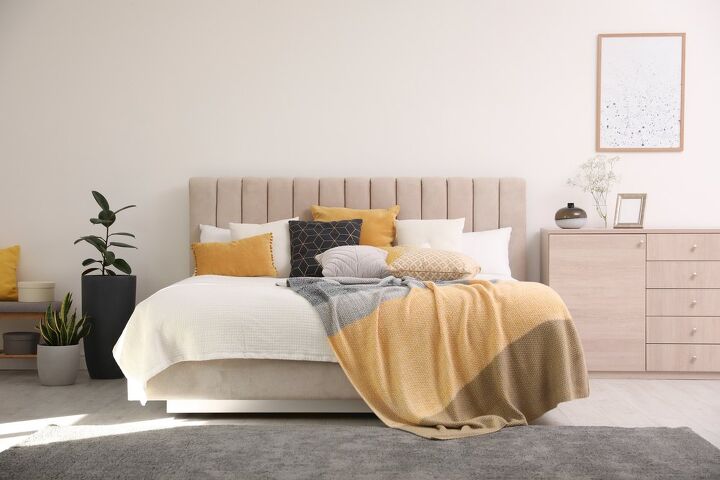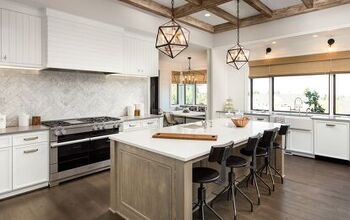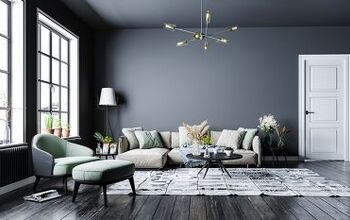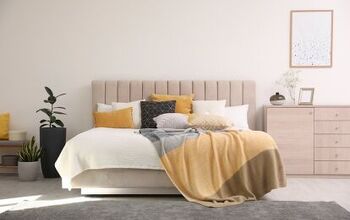Are You Making These Design Mistakes In Your Bedroom?

Is your bedroom a peaceful place that sends you off into a sweet slumber, or is it a design nightmare? Your bedroom should be a retreat that evokes a sense of calm and well-being. But if you’re making design mistakes in your bedroom, it might be hard to unwind and relax.
Avoid using too much furniture or pieces that are too big for the space. Add window treatments for privacy and a rug for texture and warmth and to anchor the space. Pillows provide an opportunity for coziness but don’t use too many. Use consistent, adequate lighting that you can dim, and make sure there’s enough space to maneuver around the bed.
If you feel your bedroom is coming up a bit short in the design department, start with this list to see if you can pinpoint the problem. These design mishaps aren’t necessarily deal-breakers, but they tend to make a space feel a bit lackluster.
10 Common Design Mistakes In Bedrooms
Most of these design misses are easy to correct with a little effort and a minimal budget. In some cases, simply removing a couple of items or swapping them out for more fitting pieces will work wonders.
1. Weird Bed Placement
Your bed is the biggest item in your bedroom, which often means it becomes the focal point of the space. Therefore, if it’s in a strange place, it can throw off the entire balance and look of your room.
Plus, strange placement can also lead to issues with practicality, such as not enough space to get in and out of bed. Your bed should ideally have a 36-inch clearance on each side and at the foot. If you can’t swing that, go for 24 inches, or at the very least 18 inches of clearance.
Typically, the best placement for your bed is centered on the wall. Placing your bed too close to a wall or extremely off-center in your space looks strange and isn’t the most convenient option.
2. Forcing A Bed That’s Too Big
As you consider the placement of your bed, also make sure you have the proper sized bed for your room. If you can’t achieve at least 18 inches on each side and at the foot, you need a smaller bed. However, if you have an expansive bedroom, don’t pick a bed that’s too small and looks lost in space.
Think your bed’s size is bringing down your design? Don’t stress out about it. You don’t need to run out and purchase a new bed right away, but put it on your to-do list.
It’s a good idea to replace your mattress every 7 to 10 years anyway. Therefore, at the very least, make a note to get the right-sized bed when it’s time to find a replacement.
3. Insisting On Having Nightstands
This tip is geared more toward smaller bedrooms. If you’re limited on space, don’t feel you have to have nightstands on each side of the bed. Bedside tables are a common addition to a bedroom and provide convenience. But if there’s no room, these two extra furniture pieces make things look cramped.
Instead, nix the nightstands. If you must have something near your bed for essentials like your glasses, phone, etc., think outside the box. Choose an alternative that works with your bedroom’s overall design scheme. A chair that doubles as a nightstand, a floating shelf, or even a stack of books can serve a similar purpose.
4. Too Many Pillows
Pillows add an extra layer of coziness and texture to your bedroom, and also add style to your bed. They can make your bed look luxe and rich or plush and comfy, depending on your desired look. But don’t go overboard, and keep pillows to a manageable amount.
Piling too many pillows on the bed starts to get a bit impractical. You need to pull them all off every night, figure out where to put them, or they end up all over the floor. Then, when you make your bed, you need to put them all back in place again.
5. Not Including A Rug
Many people tend to forget about adding a rug when it comes to their bedroom. Maybe it’s because the bed takes up so much floor space, you figure you don’t need anything else covering the ground. But neglecting to add a rug to the design is a miss.
A rug adds warmth, texture, and helps ground the space and brings the whole room together. However, it needs to be the right-sized rug to work. Get a rug that fits under the bed and extends out a bit on each side and the foot of the bed.
It doesn’t need to go under the entire bed, but it looks best if it fits under at least three quarters of it. If it’s slightly smaller than this, it’s still workable, as long as it extends beyond the foot and sides of the bed.
6. No Seating When There’s Room For It
Failing to add seating (if there’s room for it) is another design miss in a bedroom. Having seating tends to elevate the design and ups the coziness factor, which is always a plus for the room you use for sleeping.
If you have a large room, a seating area with a couple of chairs or a loveseat and chair works well. You can create a conversation zone or reading nook.
If you have a more conservative space, a bench at the foot of the bed or chair in a corner adds an extra place to sit. This extra seating is perfect for putting on shoes or chatting with your partner as they get ready.
7. Poor Storage Options
One thing that’s always a design mistake is clutter. And if you don’t have adequate storage, clutter becomes inevitable unless you’re embracing minimalism. Maximize your closet with shelving and storage options that utilize every inch of space.
If you don’t have a designated place for clothes, store clothes without a closet using an armoire, wall hooks, and other means. For example, use the area under the bed if you’re pressed for space, get a dresser, or get creative.
Rotate clothing by season to decrease how much you need to store in your room at one time. Keep shoes in a storage bench at the foot of the bed, or roll-up t-shirts in an over-the-door organizer.
8. Mismatched Lighting
To relax in your bedroom, it’s vital that you create the right mood. Poor lighting, lights that are too bright, and mismatched color temperatures are anything but relaxing. Have a variety of lights, such as your overhead light, lamps on the nightstands, or a floor lamp.
Make the lights in your bedroom dimmable and see that they’re all the same color temperature. Although a warmer temperature tends to add a cozier vibe, if you prefer cool, go with that. It’s your room, your choice. The main thing is that whatever color temperature you choose, use the same throughout the space.
If you don’t have any overhead lighting, consider other ways to add lighting, such as through wall sconces, rope lights, or hanging lights. You can find styles that don’t require hardwiring, using battery-operated bulbs to achieve the look and feel you want without needing to call an electrician.
9. Furniture That Doesn’t Fit The Scale Of The Space
Another bedroom design mistake is using furniture that’s off scale with the size of the space. For example, if your bedroom has high ceilings, using low-profile furniture, like a short, long dresser, and small headboard, looks lacking. Instead, use vertical dressers, a tall headboard, or an armoire to help fill the vertical space.
On the contrary, if you have a smaller room, using these larger, taller pieces creates a cramped, busy space. The result is a room that doesn’t feel very calm or relaxing. In a smaller space, opt for low-profile, streamlined pieces.
10. No Window Treatments
Failing to hang window treatments doesn’t work out too well in a bedroom. First, you need a way to block out the light, especially if your schedule calls for you to sleep during the day.
Also, a bedroom is where you undoubtedly need and desire privacy. Window treatments provide function and form, making them essential design components. Choose coverings that work with your room’s style and provide texture and warmth to the space.
Ditch These Bedroom Design Nightmares, And Say Hello To Sweet Dreams
Stop losing sleep over bedroom design mistakes. A few simple changes and choosing the right sized furniture makes a big impact on the space. Layer in textures through pillows (but not too many), a rug, and window treatments.
Create a relaxing space with proper lighting that features matching color temperatures, preferably in a warm white. And keep your bedroom tidy with ample storage and creative organizing solutions. After a few thoughtful tweaks, you’ll be drifting off to dreamland before you can say, “sweet dreams.”
Related Guides:

Stacy Randall is a wife, mother, and freelance writer from NOLA that has always had a love for DIY projects, home organization, and making spaces beautiful. Together with her husband, she has been spending the last several years lovingly renovating her grandparent's former home, making it their own and learning a lot about life along the way.
More by Stacy Randall



























